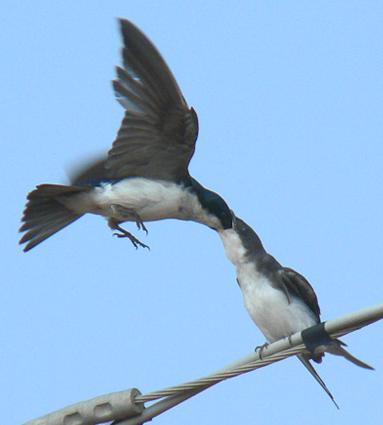Swallow - Tree
Scientific Name: Tachycineta bicolor
Fri, 1st November, 2024 - 8:17 am GMT
Sponsor Ads:

Alternative Name
Scientific Name: Tachycineta bicolorBasic Info
Male Tree Swallows are dark blue to blue-green in color. Females have more green in their coloring and may have brown feathering as well, especially younger birds. The wings of Tree Swallows are quite narrow. The feathers have a beautiful iridescent shine to them, giving the Tree Swallow a glossy appearance. The cheeks and undersides of the Tree Swallow are white. Their beaks are black and quite short, and the legs are brownish gray or reddish brown. They terminate in small feet. Immature Tree Swallows have very different coloration. Although the tail and wings may have a faint greenish wash, they are predominantly grayish brown. Also, juvenile Tree Swallows may have a light gray stripe over their breasts.
Health
Tree Swallows readily use nesting boxes when such items are provided for them, and if you wish to attract or shelter a Tree Swallow you may wish to hang such a box near your home. Breeding Tree Swallows mate for the duration of the breeding season, building nests spaced about 15 meters apart from each other and defending these small territories from other birds. Often the same pairs will mate again in the next breeding season. Tree Swallows' nests are built by the females in the spring, usually early May. The nests are built high off of the ground from pine needles and grass, and the birds line the nests with their feathers. Generally, a Tree Swallow will produce a clutch of four to seven eggs, laying one egg per day. They will incubate for about two weeks. Between 16 and 30 days after hatching, they become independent and leave the nests.Habitat
They prefer freshwater habitats.Behavior
With their lovely colorful plumage and iridescent sheen, the Tree Swallow is one of the most beautiful little birds in the wild. Tree Swallows spend the summer in more northern parts of North America, migrating southward to warmer winter climates in the colder months. Usually they choose open ranges in which to live in, generally coastal areas of lakes, shorelines, or the edges of forests near water. Generally, Tree Swallows are highly social and travel in groups. However, during the breeding season they pair off and become quite territorial. Sometimes one male may choose two females, staying with the mate or mates until the breeding season is over. Tree Swallows are highly acrobatic fliers and will bathe in mid-flight by swooping down from the air, grazing the water, and shaking off the water as they ascend.Origin
North AmericaHistory
Native to North and Central America, Tree Swallows range from Canada all the way down to Mexico in their migratory patterns. Migration is truly an impressive sight from the ground, as flocks of thousands or even millions of Tree Swallows soar overhead. Because Tree Swallows readily use nesting boxes, scientists have found it relatively easy to study them. It has been found that Tree Swallows are affected by pesticides, and birds in which high levels of these toxins are found produce fewer chicks and smaller chicks than healthy birds. Tree Swallows suffer also from habitat loss.Common Foods
In the summer, Tree Swallows eat insects, which they catch in flight. These include midges, beetles, flies, grasshoppers, moths, dragonflies, and even ants. In the winter, when insects may be scarce, Tree Swallows may eat wax myrtle berries or other berrSponsor Ads:
To believe a thing is impossible is to make it so. --French proverb
Swallow - Tree
Coded by: BGID® | ALL RIGHTS RESERVED Copyright © 2000-2024
Disclaimer | Privacy | Report Errors / Contact | Credits
















